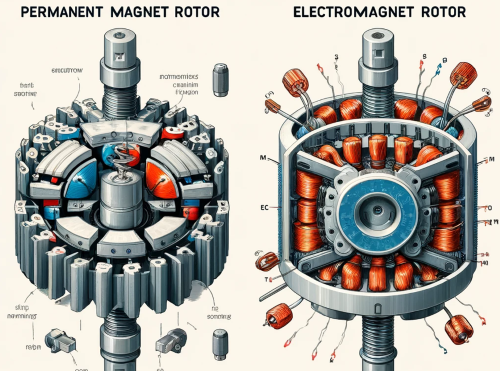Permanent Magnet Rotors vs. Electromagnet Rotors
Introduction
In the realm of electric generators and motors, the choice of rotor type is critical to the performance, efficiency, and maintenance of the system. Two primary types of rotors are widely used: permanent magnet rotors and electromagnet rotors. This comparative study discusses their characteristics, advantages, disadvantages, and applications.

Permanent Magnet Rotors
Characteristics:
– Composition: Permanent magnet rotors are embedded with materials such as neodymium, samarium-cobalt, or ferrite magnets.
– Magnetic Field: They produce a constant magnetic field without the need for an external power source.
– Design: Typically found in both axial flux and radial flux configurations.
Cons and Pros:
Permanent magnet rotors offer several advantages that make them highly efficient and reliable. Firstly, they provide high efficiency as the permanent magnets ensure a consistent magnetic field, which significantly reduces energy losses. This leads to an overall increase in the generator’s efficiency. Additionally, the design simplicity of permanent magnet rotors, due to the absence of windings on the rotor, minimizes the likelihood of mechanical failure. Another notable benefit is their low maintenance requirement, as there is no need for brushes or slip rings, which are common points of wear in other types of generators.
Despite these benefits, permanent magnet rotors do have some drawbacks. High-quality permanent magnets can be expensive, increasing the initial cost. There is a demagnetization risk as well. Permanent magnets can lose their magnetism if exposed to high temperatures or physical shocks. Last, the magnetic field strength cannot be adjusted, limiting control over the generator’s output.
Applications:
– Wind turbines
– Electric vehicles
– Portable generators
– Small-scale hydropower systems
– Marine energy systems
Electromagnet Rotors
Characteristics:
– Composition: Electromagnet rotors have windings through which an electric current is passed to create a magnetic field.
– Magnetic Field: The magnetic field is generated by the flow of current through the rotor windings.
– Design: Typically used in traditional radial flux designs.
Cons and Pros:
Electromagnetic generators offer several advantages, including adjustable field strength, allowing the magnetic field to be varied by changing the current flow, providing greater control over the generator’s output. They are also generally more cost-effective to produce compared to high-quality permanent magnet rotors. Additionally, these generators are capable of generating strong magnetic fields, making them suitable for high-power applications.
However, there are notable drawbacks to electromagnetic generators. They require a continuous supply of electrical power to maintain the magnetic field, which reduces overall efficiency. Maintenance is also a concern, as brushes and slip rings are needed to supply current to the rotor windings, necessitating regular upkeep and replacement.
Applications:
– Large-scale power generators
– Industrial motors
– Electric traction systems
– Synchronous generators in power plants
Comparative Analysis
1. Efficiency:
– Permanent magnet rotors are more efficient due to their consistent magnetic field and lack of energy consumption to maintain the field.
– Electromagnet rotors, while capable of high power output, consume additional energy to generate the magnetic field, reducing overall efficiency.
2. Control and Flexibility:
– Electromagnet rotors offer greater control and flexibility with adjustable field strength, making them ideal for applications requiring variable power output.
– Permanent magnet rotors have fixed magnetic field strength, limiting control but simplifying design and operation.
3. Cost:
– Permanent magnet rotors typically have higher initial costs due to the price of high-quality magnets.
– Electromagnet rotors can be more cost-effective initially but may incur higher operating and maintenance costs over time.
4. Maintenance:
– Permanent magnet rotors require less maintenance due to the absence of brushes and slip rings.
– Electromagnet rotors need regular maintenance of brushes and slip rings, increasing downtime and maintenance costs.
5. Applications:
– Permanent magnet rotors are preferred in applications where efficiency, low maintenance, and compact size are critical.
– Electromagnet rotors are chosen for applications requiring high power output, adjustable magnetic fields, and cost-effectiveness.
Conclusion
The choice between permanent magnet rotors and electromagnet rotors depends on the specific requirements of the application. Permanent magnet rotors offer high efficiency, low maintenance, and compact design, making them suitable for renewable energy systems, electric vehicles, and portable generators. Electromagnet rotors, with their adjustable field strength and cost-effectiveness, are ideal for large-scale power generation, industrial motors, and applications requiring variable power output.
Understanding the advantages and disadvantages of each type allows for informed decisions in selecting the appropriate rotor for optimal performance and efficiency. For more information, please check Stanford Magnets.